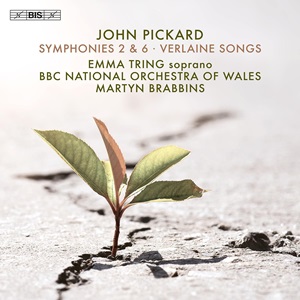
John Pickard (b. 1963)
Symphony No. 2 (1985/1987)
Verlaine Songs (2019/20, orch. 2022)
Symphony No. 6 (2021)
Emma Tring (soprano)
BBC National Orchestra of Wales/Martyn Brabbins
rec. 2023, Hoddinott Hall, Cardiff, UK
BIS BIS-2721 SACD [72]
Quite early in his composing career, John Pickard was drawn to symphonic music and to chamber music, particularly string quartets. He composed Symphony No 2 over a two-year period, as he explains in the booklet notes. He had extra-musical basic ideas and considered how vegetation survives even cataclysmic events such as the atomic blast in Hiroshima or – nearer to us – contamination by industrial waste, and how it regenerates and redevelops. This is roughly what to listen for in the Symphony, although no underlying programme points towards descriptive music. The work is development-oriented in a genuinely symphonic manner.
Pickard planned his work carefully at first but, as he writes, “the music began to fight back against [my] carefully predetermined plan until it threatened to dislodge it completely […] intellect began to give way to instinct; control to yield to freedom”. One element of the original plan remains. The single-span structure has six sections, each metrically derived from the previous one and tracing a gradual acceleration, until the climactic final section returns to the tempo of the opening. Each section is also five-sixths the length of the preceding one. If this sounds dryly technical, the end result is clearly heard throughout the work, and the whole structure sounds like a huge crescendo.
Pickard also readily admits that he had not expected “the sheer ferocity and remorseless drive of the music that emerged”. True, after the suspended, hesitant opening of the first section, the music accumulates much energy over the length of the piece. After a final shattering climax, the very beginning is briefly restated, bringing the piece full circle. This is a remarkable achievement, for the composer to be proud of – a powerful piece clearly penned by a born symphonic writer. (He still lists Symphony No 1 from 1983-1984, but says that it is withdrawn for revision, and is still unperformed. If it is recorded, one will be able to assess Pickard’s symphonic progress.)
Pickard wrote the Verlaine Songs for soprano Emma Tring, in three versions. One is scored for voice and ten instruments, another from 2022/2023 for voice, violin and piano. Here we get the 2022 version for voice and chamber orchestra. Many composers have set Verlaine’s poems, including Fauré, Debussy and Ravel.
Chanson d’automne begins with these, perhaps familiar, words: Les sanglots longs / Des violons / De l’automne / Blessent mon coeur / D’une langueur / Monotone. The setting is moving in its utter simplicity. Spleen is in a similar vein, which the composer describes as languorous and subjective. Marine paints a stormy seascape. Le Squelette is a macabre Scherzo: two drunken soldiers try to offer a drink to a skeleton, who sits up and sends them on their way; piano and xylophone help create a sinister atmosphere. L’heure exquise brings welcome relief; it is a wonderful nocturne in all but name, and for me the finest song of the set. Le soleil d’or is a “joyful description of the rising sun”. There is much fine stuff in this cycle. It is good to have it sung with such commitment and consummate musicality.
The Symphony No 6 is a by-product of the Covid-19 lockdown. Pickard recalls that he wanted to write something more lightweight than the preceding symphonies, but things turned out differently and the music soon developed in other directions. There are two movements. The first initially seems to adhere to the original plan. It begins “gently, almost playfully” but the mood quickly changes. The music becomes more assertive and troubled, and swells to a massive climax.
The second movement “seeks a response to the trauma wrought by the climax of the first movement”. The same material is viewed from a radically different perspective. The brooding, tense opening turns into a rather sombre funeral march, which intensifies and leads into a mighty climax. There follows what the composer describes as “a kind of nature music” trying to bring relief after the oppressive darkness of the first part of the second movement. The final minutes are “hushed and expectant in character”, not unlike the epilogue of Vaughan Williams’s Sixth Symphony. This is yet another impressive and powerful achievement, and a strongly personal statement.
The disc is a splendid addition to John Pickard’s growing discography. The playing and the recording are outstanding. The composer’s notes (from which I have generously quoted, with thanks) are clear, unfussy and spot on. I recommend this fine release to any follower of Pickard’s music, but it should appeal to anyone with a liking for strongly expressive, accessible music.
Hubert Culot
Buying this recording via a link below generates revenue for MWI and helps us keep free access to the site



















